What is Arc Flash: Definition, Causes, Requirements and Solutions
Builders, electricians, and trade workers face a number of risks on the job. Challenging or unsafe environments can lead to injuries like falls, slips, and trips(opens in a new tab). More than 1,000 construction site deaths each year(opens in a new tab) — along with 174,000 non-fatal injuries — highlight the dangers that workers face.
One major risk that workers face is arc flash, which occurs when a discharge from an electrical current travels through the air between conductors. Arc flash can cause serious injury, including severe burns to those working nearby, and can take out anything else in its path. Unfortunately, it can even lead to death.
Arc flash defined
Arc flash is a flashover of electric current. Light and electricity are released into the air after an arc fault, and when it reaches another conductor or the ground, an explosion occurs, creating a wave of heat that can melt and burn anything nearby, including people. An arc flash event can have effects that mirror those of a bomb and can cause lasting damage to people, equipment, and buildings. Arc flash can be caused by mistakes like accidentally touching exposed wires. In other cases, arc flash results from natural factors like corrosion, dust collection, or condensation.
Arc flash is different from other electrical risks. Unlike electrical shock, arc flash doesn’t always subject the body to a current. While electrocution commonly affects normal heart rhythm, arc flash is simply a risk associated with the uncontrollable release of energy into the air.
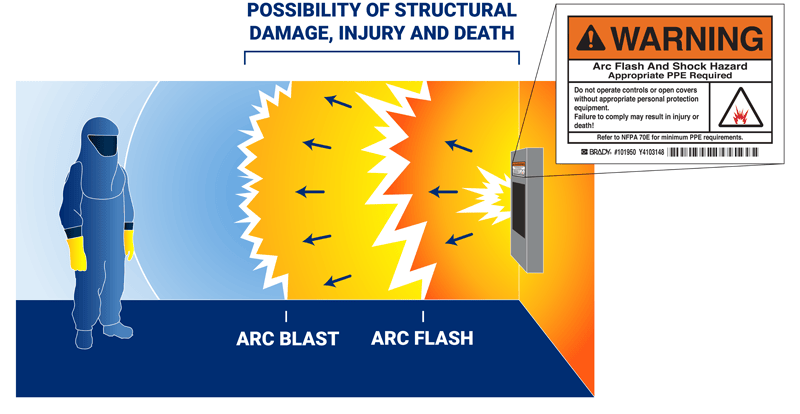
Arc flash vs. arc blast
Arc flash and arc blast are two different, but related, results of an electrical discharge.
“Arc flash” refers to the energy released from an electrical arc. The energy lets off intense heat and light, which can cause burns. Arc flashes also release air and gas into the atmosphere — a phenomenon known as “arc blast.”
Arc blast is the pressure wave created by an arc flash, pressure that can cause all sorts of damage to structures, equipment, or nearby workers. Both arc flash and arc blast create serious hazards to workers, particularly those who work in close proximity to electrical systems.
Causes of arc flash
Arc flash is caused by failures in electrical insulation or circuits. These failures create a breakdown in the insulation surrounding electrical conductors, where a fault in the circuit creates a live current through the air instead of through the intended wire or path.
Poor maintenance
— Some arc flashes are the direct result of poor maintenance. Over time, electrical equipment can degrade and wear down, leading to the failure of insulation that increases the risk of an arc flash. Loose connections can also cause arcing or overheating and lead to an arc flash event.
Environmental factors
— Environmental factors like moisture, dust, debris, or condensation can also cause issues with electrical insulation, further heightening arc flash risk.
Human error
— Improper work practices or equipment failure is also known to elevate arc flash risk. When workers fail to follow proper lockout tagout procedures or neglect to wear appropriate personal protective equipment when working with electrical systems, they can contribute to arc flash risk. Other human-related mistakes, such as accidentally touching energized circuit parts or incorrectly installing or wiring equipment, can also lead to an arc flash event. It’s also important for employees to be aware of warning signs, like excessive heat or noise, that indicate equipment failure is imminent.
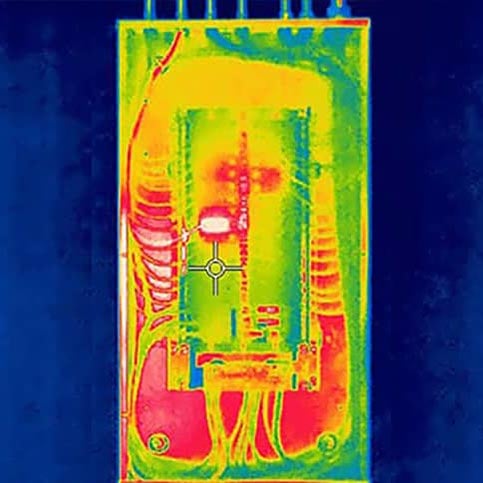
Dangers of arc flash
Arc flash is a dangerous event that can pose significant risks for both the property and the people nearby.
Two of the most serious consequences of arc flash are burns and blast injuries. Burns can be life-threatening and may require extensive medical treatment. Blast injuries range from minor cuts and bruises to serious injuries, including broken bones and internal contusions.
Many arc flashes also create structural damage, typically through the resulting arc blast and fire. Arc blast creates a wave of pressure, sometimes significant enough to damage infrastructure. This damage can compromise the safety of a structure, leading to costly repairs and work slowdowns.
Fire can further damage nearby equipment in the minutes after arc flash occurs. If flames reach vulnerable materials or chemicals labeled as hazardous, the same arc flash could also create toxic air, smoke, and pollution that quickly spreads.
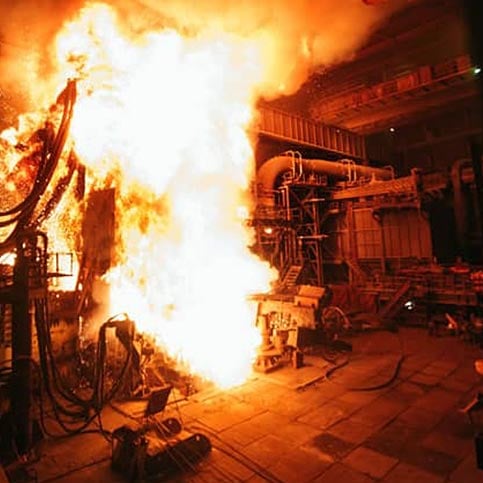
How to prevent arc flash
Preventing arc flash is possible through a variety of proactive safety measures. These steps typically include annual infrared thermography inspections, regular maintenance, regular training for workers, proper installation of materials, labeling electrical equipment, and wearing personal protective equipment.
Wear PPE
Personal protective equipment (PPE) can protect workers from the various dangers of arc flash. The right PPE helps to create a barrier between workers and an arc flash event.
PPE designed for electrical protection will typically include flame-resistant clothing. These protective garments are made with flame-resistant materials that help prevent or reduce the severity of burn injuries from an arc flash. A flame-resistant PPE outfit might include gloves, shirts, pants, boots, and a face shield.
Hard hats are also an integral part of many workers’ PPE. Wearing a hard hat can protect workers from falling debris or any other physical hazards created by an initial arc flash.
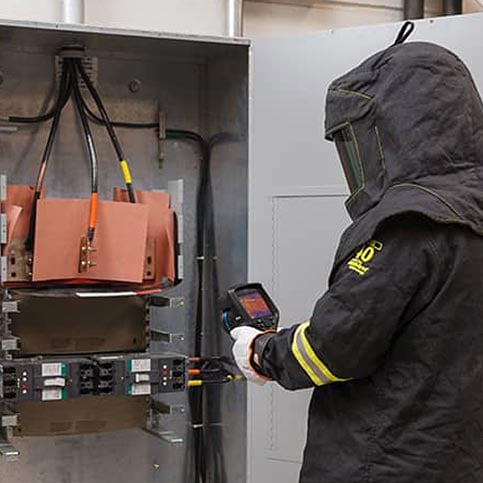
Labeling electrical equipment
Proper labeling of electrical equipment can also help protect against arc flash. If arc flash does occur, the same electrical labeling techniques can help limit damage and make cleanup an easier, safer process.
Labeling electrical equipment provides workers with critical information about the hazards in a specific area. This information includes voltage and current levels, which can increase awareness and encourage workers to take all appropriate precautions.
Proper labeling of electrical equipment can also help construction organizations maintain compliance with local, state, and federal construction regulations. These regulations often include work standards, proper documentation, regular audits, and labels identifying arc flash risks.
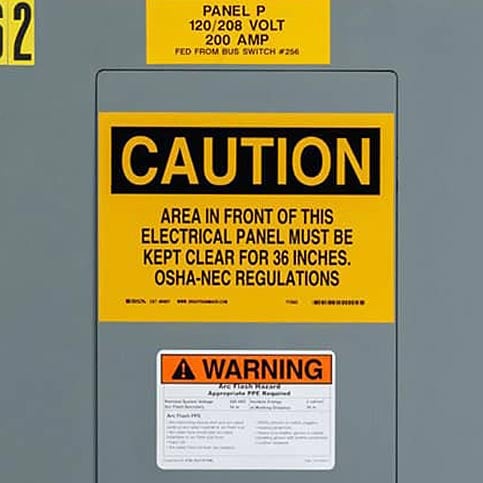
Keep a safe distance
One of the easiest ways to limit the effects of arc flash is to simply keep a safe distance from potential risks. This means identifying arc flash boundaries and staying clear of those zones unless your work requires close proximity to an arc flash risk area.
Consider automating your work whenever possible, particularly around arc flash boundaries, to limit potential human exposure. Controlling electrical equipment remotely isn’t always easy, but it can go a long way toward reducing the risk of arc flash.
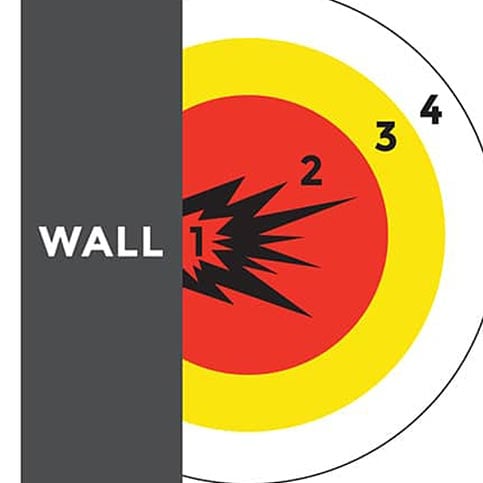
Train workers in risk assessment
Workers should all be trained on the dangers of arc flash and how to maintain an effective distance from potential risk zones. When a worker’s responsibilities require closer proximity to electrical systems, they should also understand how to follow safe work practices.
Arc flash risk assessments should be an important part of workers’ training. This includes identifying potential threats and taking appropriate preventive measures before a risk emerges. Follow the Hazard Communication Standard (HCS) to ensure all workers can evaluate hazards, read labels, access Safety Data Sheets, and protect themselves against arc flash and other work-related risks.

OSHA arc flash labeling and PPE requirements
The Occupational Safety and Health Administration (OSHA) is one of several national authorities that maintain strict standards for workplace safety, including arc flash protection. These standards are designed to protect workers from electrical dangers while outlining steps to enhance workplace safety.
These standards include specific measures to protect workers from flames and electrical arcs(opens in a new tab). Under 29 CFR 1910.269, employers must assess a workplace for flame and electric-arc hazards, estimate the heat energy an arc would create, and ensure that employees wear protective clothing that will not melt or burn.
29 CFR 1910.333 emphasizes the importance of workplace habits that protect against electrical hazards(opens in a new tab). These measures should include de-energizing any structures before employees interact with them. This OSHA standard is often upheld through the NFPA 70E Standard, which outlines a facility’s minimum responsibilities in complying with arc flash safety requirements.
